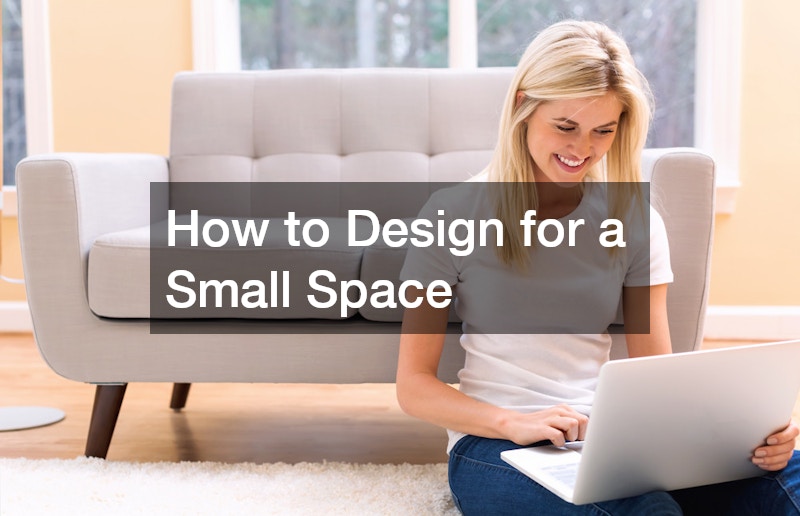
How to Design for a Small Space
Designing for a small space requires a balance of creativity and practicality. Whether you’re a homeowner working with limited square footage or looking to buy a smaller home, the key is to make the most of every inch while keeping the space functional and visually appealing. Below are essential tips to help you maximize your space without sacrificing comfort or style.
1. Opt for Multifunctional Furniture
In a small home, furniture must do more than look good—it should serve multiple functions. Multifunctional furniture allows you to combine several pieces into one, saving space and reducing clutter.
This approach will help you make the most of your limited floor area while keeping the room organized and spacious.
- Choose furniture that doubles as storage, like beds with built-in drawers or sofas with hidden compartments.
- Use benches that can be used for seating and also have storage space underneath.
- Consider fold-down tables or wall-mounted desks that can be stored away when not in use.
- Invest in pieces like storage ottomans or coffee tables with hidden storage to keep clutter out of sight.
2. Keep the Space Organized
Keeping a small space tidy and organized is essential for maintaining an open and airy feel. Clutter can quickly make a small room feel cramped and chaotic, but with smart storage solutions and regular decluttering, you can keep your home looking and feeling larger.
- Assign specific storage spaces for items, such as designated cabinets, shelves, or storage bins.
- Mix open and closed shelving to display some items while hiding clutter in closed cabinets.
- Regularly declutter by donating or throwing away items you no longer need.
- Store infrequently used items in a “transition box.” If you don’t use the items after a month, consider getting rid of them.
3. Use Light Colors to Open Up the Space
Color plays a crucial role in how a room feels, especially in a small space. Lighter colors like white, pale gray, and soft pastels reflect light and give the room an airy, open feel. Dark colors, on the other hand, tend to absorb light and make the space feel smaller.
- Paint the walls white or in another light color to reflect more light around the room.
- Choose a warm undertone in the paint to avoid a cold, clinical feel in the space.
- Paint trim and moldings a slightly lighter color than the walls to create the illusion of depth.
- Stick to a minimal color palette to avoid visual clutter, which can make a room feel smaller.
4. Add Accent Walls for Interest
An accent wall can provide visual interest in a small room without overwhelming the space. By drawing the eye to a specific area, accent walls can make the room feel larger by allowing other areas to “breathe.” Just be careful not to overdo it, as too many accents can clutter a small space.
- Create an accent wall by painting one wall in a different, bold color.
- Use wallpaper with large patterns to make a focal point without adding visual clutter.
- Add an accent with a different material, like wood paneling or a brick feature wall.
- Limit the accent to one area of the room to prevent the space from feeling too busy.
5. Use Mirrors and Reflective Surfaces
Mirrors and reflective surfaces can be your best friends in a small space. By reflecting light and creating the illusion of depth, these items can make a room feel much larger than it really is. Thoughtfully placing mirrors or using shiny materials can significantly increase the feeling of space.
- Place a large mirror opposite a window to reflect natural light and brighten the room.
- Use mirrored or reflective furniture pieces, like glass or marble tabletops, to bounce light around the space.
- Consider a tall, slender mirror to draw the eye upward, making the room appear taller.
- For renters, consider leaning an oversized mirror against a wall to create the illusion of more space without permanent installation.
6. Choose Low-Profile Furniture with Legs
Low-profile furniture can make a room feel more spacious by allowing air and light to flow underneath. Furniture that is too large or bulky can weigh down a small room, making it feel crowded and claustrophobic. Choosing smaller, more streamlined pieces will give your space a cleaner, more open look.
- Opt for furniture with legs, which allows light and air to circulate underneath.
- Avoid oversized sofas or chairs with heavy arms and large backs, which can make the room feel cramped.
- Choose sleek, low-profile furniture, especially for larger items like sofas or dining tables.
- Consider alternatives like side tables instead of large coffee tables to free up floor space.
7. Round Furniture for Softness and Flow
Furniture with round edges can make a small room feel softer and more inviting. Sharp corners can interrupt the flow of a space, while round pieces create a more continuous, organic feel. This can help make the room feel less confined and more spacious.
- Use a round dining table or coffee table to save space while creating a smooth flow in the room.
- Consider round rugs to soften the look and make the space feel more open.
- Round chairs or ottomans can add softness without taking up too much space.
- Avoid furniture with sharp, angular edges, which can make a small space feel more confined.
8. Leave Space Between Furniture
Leaving enough space between your furniture is crucial in small spaces. It might seem tempting to place furniture close together to fit everything in, but doing so can make the room feel cramped. Leaving space around pieces allows for better movement and creates the illusion of a larger room.
- Keep at least 45-60 centimeters of space between larger furniture pieces to ensure easy movement.
- Pull furniture slightly away from walls to create depth and make the room feel more open.
- Try angling some pieces, like an armchair or a side table, to make better use of corner space.
- Arrange your furniture to allow for natural walking paths throughout the room.
9. Emphasize Vertical Elements
Using vertical space in a small room helps create the illusion of height, which can make the room feel more open. By drawing the eye upward, you can enhance the feeling of spaciousness even in a compact area.
- Install floor-to-ceiling shelving to make the room appear taller and provide additional storage.
- Hang tall mirrors or artwork to emphasize the height of the room.
- Use vertical paneling or tall, slim furniture to add to the room’s sense of height.
- Incorporate long, hanging light fixtures to draw attention to the vertical space.
10. Use Blinds Instead of Curtains
Blinds are a great way to maximize natural light, which is essential for making a small space feel bigger. Curtains, especially heavy or dark ones, can block light and crowd the room, while blinds are minimal and unobtrusive. Lightweight, airy fabrics can also work well if you prefer curtains.
- Choose roller blinds that roll up completely to expose the full window.
- Pick blinds in the same color as the walls to create a seamless, open look.
- If you prefer curtains, use lightweight, breezy fabrics in white or neutral tones to keep the room light and airy.
- Hang curtains high and wide to create the illusion of taller windows and more space.
11. Install Flat Roof Skylights
Natural light is one of the most effective ways to make a small space feel larger, and flat roof skylights are a great option if your home lacks sufficient windows. By bringing in daylight from above, skylights brighten the room and create a more open, airy atmosphere.
- Install flat roof skylights in areas like the kitchen or living room to maximize light.
- Skylights create the illusion of height and expand the room visually.
- Flat roof skylights are ideal for homes with limited windows or in areas that don’t receive much direct sunlight.
- Use skylights to transform dark or narrow spaces into bright, inviting areas.
12. Layer Your Lighting
Lighting is key in a small space, especially at night or in areas with limited natural light. By layering your lighting, you can create a warm, spacious feel. Use a combination of ambient, task, and accent lighting to brighten the room and add dimension.
- Use overhead lighting for general illumination, such as recessed lights or track lighting.
- Add task lighting with table or floor lamps for focused areas like reading nooks or workspaces.
- Use accent lighting, such as sconces or under-cabinet lights, to highlight specific areas and create depth.
- Avoid bulky light fixtures that take up space; instead, opt for sleek, minimalist designs.
13. Consider Sliding Doors
Sliding doors are an excellent space-saving alternative to traditional hinged doors. In small spaces, where floor space is at a premium, sliding or pocket doors can make a big difference. They allow for more usable space and a smoother flow between rooms.
- Install sliding doors that sit flush with the wall, saving space when opened.
- Consider pocket doors, which slide into the wall and virtually disappear when open.
- Sliding doors work well in areas with limited space, like bathrooms or closets.
- Use glass sliding doors to maintain an open feel and let natural light flow between rooms.
By incorporating these design strategies, you can make the most of your small space. From choosing multifunctional furniture to maximizing natural light with features like flat roof skylights, these tips will help your home feel larger, more comfortable, and more stylish.
.




